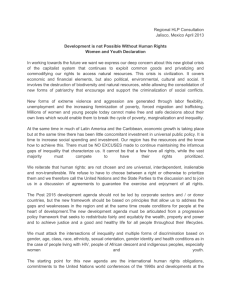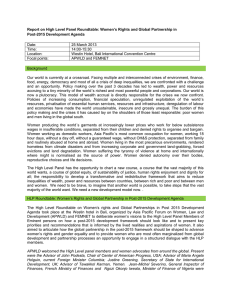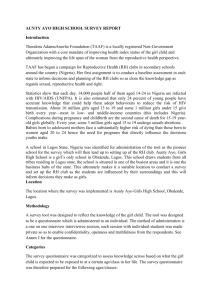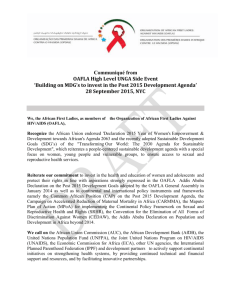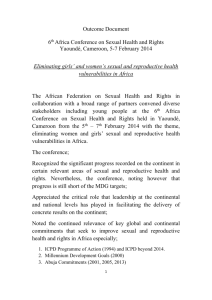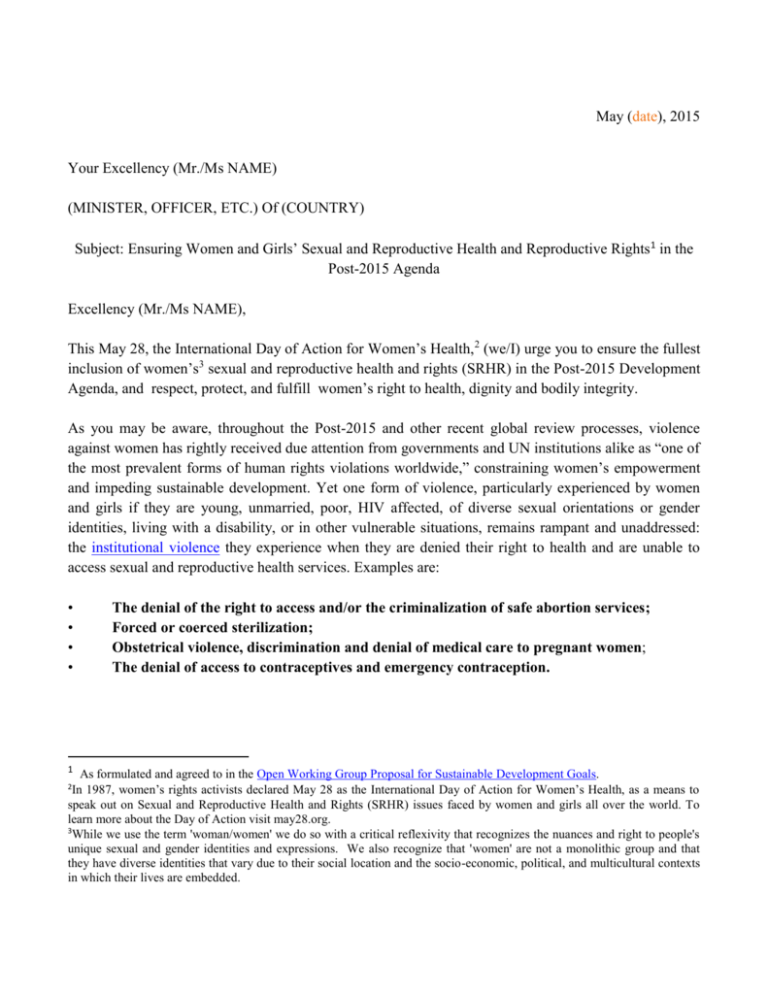
May (date), 2015
Your Excellency (Mr./Ms NAME)
(MINISTER, OFFICER, ETC.) Of (COUNTRY)
Subject: Ensuring Women and Girls’ Sexual and Reproductive Health and Reproductive Rights1 in the
Post-2015 Agenda
Excellency (Mr./Ms NAME),
This May 28, the International Day of Action for Women’s Health, 2 (we/I) urge you to ensure the fullest
inclusion of women’s3 sexual and reproductive health and rights (SRHR) in the Post-2015 Development
Agenda, and respect, protect, and fulfill women’s right to health, dignity and bodily integrity.
As you may be aware, throughout the Post-2015 and other recent global review processes, violence
against women has rightly received due attention from governments and UN institutions alike as “one of
the most prevalent forms of human rights violations worldwide,” constraining women’s empowerment
and impeding sustainable development. Yet one form of violence, particularly experienced by women
and girls if they are young, unmarried, poor, HIV affected, of diverse sexual orientations or gender
identities, living with a disability, or in other vulnerable situations, remains rampant and unaddressed:
the institutional violence they experience when they are denied their right to health and are unable to
access sexual and reproductive health services. Examples are:
•
•
•
•
1
The denial of the right to access and/or the criminalization of safe abortion services;
Forced or coerced sterilization;
Obstetrical violence, discrimination and denial of medical care to pregnant women;
The denial of access to contraceptives and emergency contraception.
As formulated and agreed to in the Open Working Group Proposal for Sustainable Development Goals.
In 1987, women’s rights activists declared May 28 as the International Day of Action for Women’s Health, as a means to
speak out on Sexual and Reproductive Health and Rights (SRHR) issues faced by women and girls all over the world. To
learn more about the Day of Action visit may28.org.
3
While we use the term 'woman/women' we do so with a critical reflexivity that recognizes the nuances and right to people's
unique sexual and gender identities and expressions. We also recognize that 'women' are not a monolithic group and that
they have diverse identities that vary due to their social location and the socio-economic, political, and multicultural contexts
in which their lives are embedded.
2
The common root cause of these examples is the denial of women and girls’ right to health, and their
right to autonomous decision-making over their bodies and their lives. The result is cruel, inhuman, and
degrading treatment paramount to torture, as recognized by Human Rights Bodies.4
In your ongoing efforts related to the Post-2015 Negotiation processes, as well as in the
development and implementation of national policies and programmes, (we/I) urge you to work
towards ensuring a comprehensive and rights-based approach to women and girls’ health
through:
•
•
•
•
•
•
Reaffirming sexual and reproductive health and reproductive rights as human rights, integral to
achieving transformative sustainable development across social, economic, and environmental
dimensions.
Incorporating the Programme of Action from the International Conference on Population and
Development (ICPD PoA), the Beijing Platform for Action, and the outcome documents of their 20
year review processes into the Post-2015 Agenda as well as into national policies and programmes.
Thoroughly integrating human rights into the Post-2015 Agenda – including the Political
Declaration, SDGs, Means of Implementation and Follow up Mechanisms – so as to ensure that the
human rights and empowerment of women, girls and young people are incorporated as a crosscutting priority of the post-2015 framework and its monitoring.
Retaining if not strengthening sexual and reproductive health and reproductive rights related targets
under both the Health and Gender Equality SDGs, as outlined in the Open Working Group Proposal
for Sustainable Development Goals.
Ensuring that the Post-2015 development goals and targets include global, regional, and national
indicators that are:5 both quantitative and qualitative, including policy, legal, and structural changes
indicators; developed in an inclusive, open, transparent, and ongoing process; both existing and new
indicators, as well as comprehensive and not arbitrarily limited in number, in order to better capture
information on areas such as SRHR, gender equality, violence and discrimination.
Prioritizing the systematic and coordinated collection, analysis, and use of data disaggregated by sex,
age, sexual orientation and gender identity, disability, location, income and other variables, to
effectively monitor progress and ensure accountability.
We cannot talk of a strong (your country) without our government respecting, protecting, and fulfilling
the human rights of women and girls in all their dimensions, including the right to sexual and
reproductive health, and acknowledging the actual needs of all women and girls in all their diversities.
4
See CAT Committee, Concluding Observations: Peru, para. 23, U.N. Doc. CAT/C/PER/CO/4 (2006); Concluding
Observations: Nicaragua, para. 16, U.N. Doc. CAT/C/NIC/CO/1 (2009); Committee on Economic, Social, and Cultural
Rights, Concluding Observations on the Combined Third, Fourth, and Fifth Periodic Reports of El Salvador,
E/C.12/SLV/CO/3-5 para. 22. See also CAT, Concluding Observations: Czech Republic, U.N. Doc. CAT/C/CR/32/2 (2004),
para. 5(k), 6(n).
5
These recommendations are based on the Women’s Major Group Position on UN Post-2015 Development Agenda
Indicators.
With this letter, (I/we) urge you to support over the remaining Post-2015 processes, as well
implement at national level, a comprehensive approach to women’s health, accounting for the full
spectrum of women and girls’ sexual and reproductive health issues, needs, and rights.
Sincerely,
(your name)


